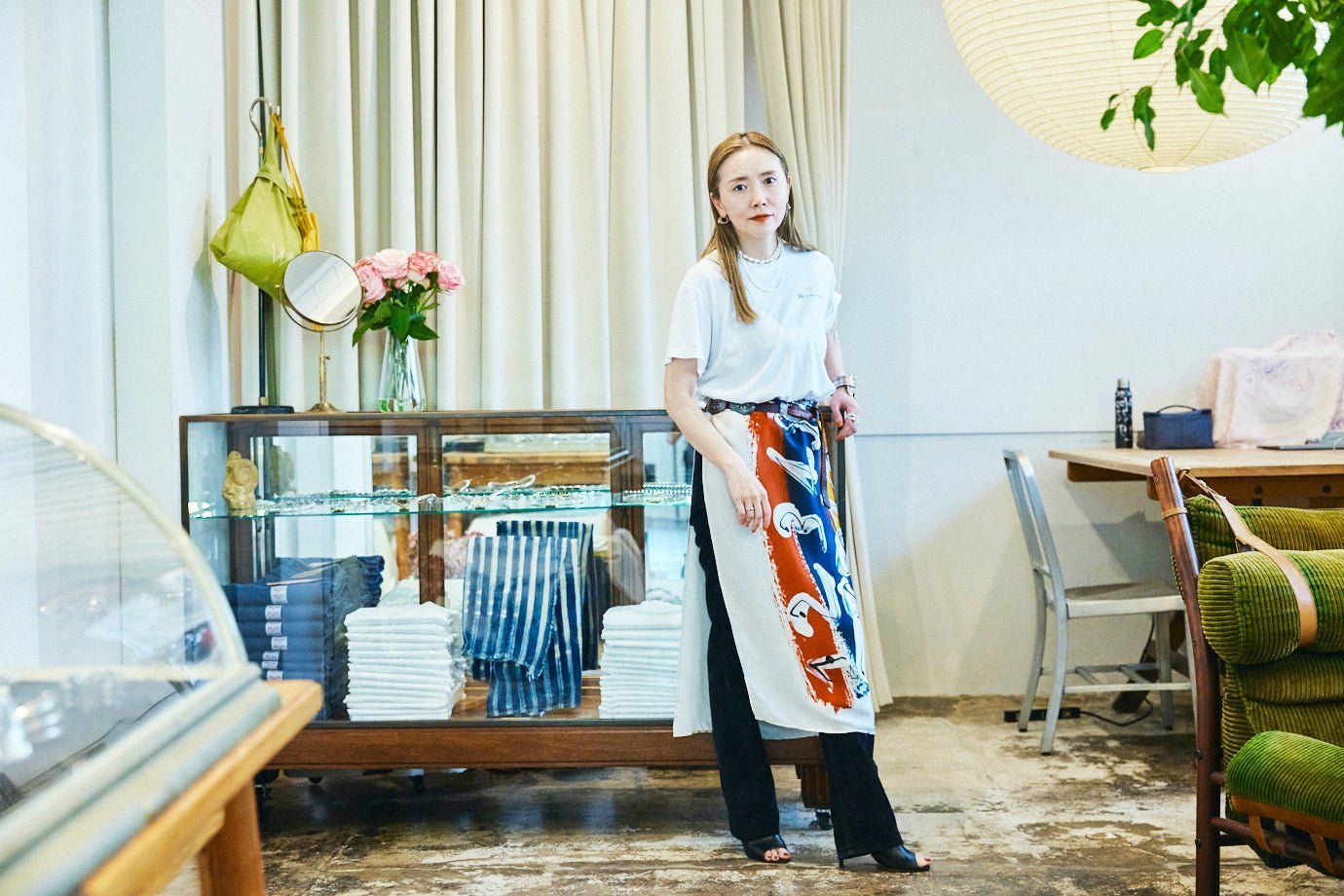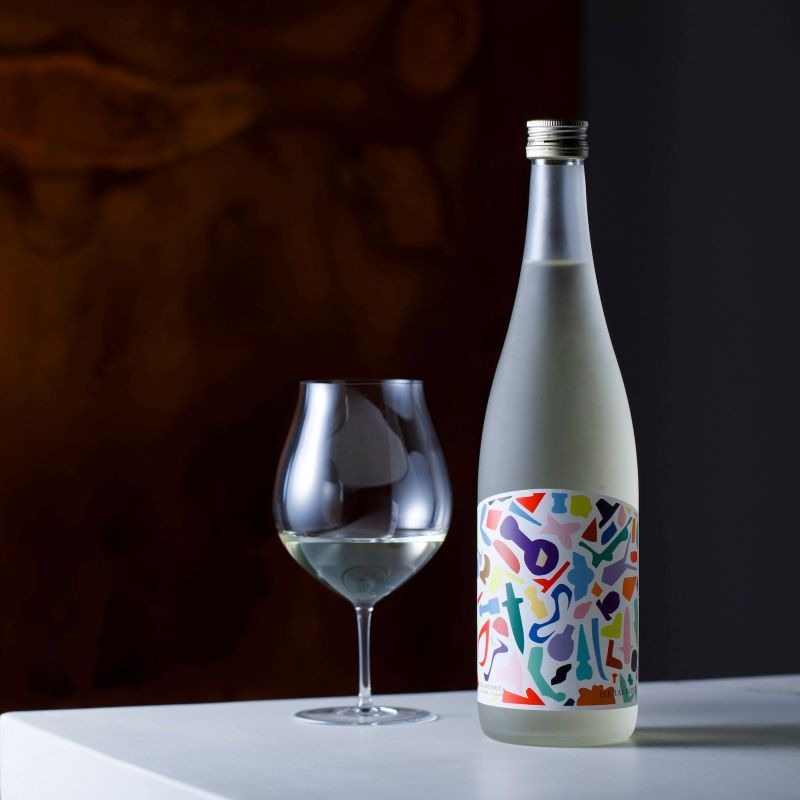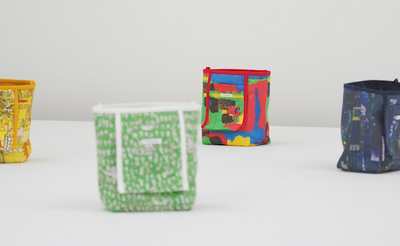"Beyond being able to draw art or not. Heralbony is our hope" Interview with the owner of the popular shop Witty Vintage

"HERALBONY & PEOPLE" is a series where we talk to people who support HERALBONY. In this series, we interview people from all walks of life who are in tune with our activities and business.
This time, we will be featuring Akamine Reiko, the owner of Witty Vintage, a vintage shop located in Yutenji, Meguro Ward, a "holy land for vintage lovers" that has garnered enthusiastic support from the fashion industry and second-hand clothing enthusiasts.
Akamine-san, who is also a mother raising a child with Down's syndrome, has publicly declared that she is an ardent HERALBONY fan. Akamine-san's posts for the SNS project "What is your difference?", which was carried out by HERALBONY on Unique Day (January 31st), garnered a lot of sympathy and emotion, and every word she spoke captured people's hearts.
 Now, a collaboration between Witty Vintage and HERALBONY has been realized. Akamine-san will talk about why he resonates with HERALBONY and his thoughts on this collaboration.
Now, a collaboration between Witty Vintage and HERALBONY has been realized. Akamine-san will talk about why he resonates with HERALBONY and his thoughts on this collaboration.The owner of a popular vintage shop is a passionate Heraldic fan.
 Witty Vintage is tucked away in a quiet residential area. The concept is witty vintage wear for grown-up women. Her husband, Akamine Yuki, is in charge of buying, while Akamine is in charge of direction. When we opened the stylish mint green door, we were greeted by a cheerful Akamine, wearing a Heralbony scarf wrapped around her high-toned hair.
Witty Vintage is tucked away in a quiet residential area. The concept is witty vintage wear for grown-up women. Her husband, Akamine Yuki, is in charge of buying, while Akamine is in charge of direction. When we opened the stylish mint green door, we were greeted by a cheerful Akamine, wearing a Heralbony scarf wrapped around her high-toned hair.  --I'm very happy that this collaboration with Witty Vintage has come true. Since I was contacted by them last year, I've been thinking, "I really want to work with you on something." First of all, can you tell us about how you first met Heralbony?
--I'm very happy that this collaboration with Witty Vintage has come true. Since I was contacted by them last year, I've been thinking, "I really want to work with you on something." First of all, can you tell us about how you first met Heralbony?Reiko Akamine (hereinafter Akamine): I first discovered them on Instagram. I took a look and wondered, "What is it?" and discovered that they were creating things based on the work of people with disabilities, so I was immediately intrigued. From there, I checked out the brand's YouTube channel, listened to a podcast hosted by the company's president, and read their book, "Unleash Your Uniqueness: "Heralbony" Changes the World with Welfare and Art." The more I learned about them, the more I thought they were amazing.
-- Thank you very much. What was it about it that you found so amazing?
Akamine: I have a son with Down's syndrome, so I'm always conscious of child welfare facilities and facilities that support people with disabilities. I'm sorry if this sounds a bit rude, but the things that are generally sold at welfare workshops are honestly pretty lame. From our perspective as people involved in fashion, my husband and I were saying, "If they produce it properly, it will sell. I'd like to be involved someday." HERALBONY is amazing because they've managed to incorporate that idea so well! Sorry if I sound condescending (laughs).
From then on, I instantly became a fan of HERALBONY. Since I also do this kind of work, I got excited thinking, "Maybe we could do something together." I couldn't stay sitting still, and before I knew it, I was sending DMs (direct messages) to the Instagram of the Matsuda Brothers, who are the company's representatives.
Akamine: I felt like I sent a letter to a senior I had a crush on in middle school (laughs). I sent a DM, but it never got read. So I thought maybe they'd notice it on the post screen, so I commented on the post, "I sent you a DM, so please check it out." Even then, it still didn't get read, but little by little, Heralbony employees started following my account. I was happy because I thought, "We're getting closer!"
After that, I contacted them through the company's inquiry form, and they replied right away. The moment I saw the message "I'd love to hear from you," I thought, "Yes!" (laughs). I learned about HERALBONY in September of last year, and in November we decided to collaborate, so this was an incident that really made me realize that "if you take action, your dreams will come true."
Fashion has the power to raise awareness of issues directly
 --It took a while from then on, but you were finally able to work together!
--It took a while from then on, but you were finally able to work together!Akamine: For our collaborative products, we hand-print or embroider art by contracted artists of HERALBONY onto our vintage items. Most vintage items are one-of-a-kind. For example, school uniforms and other items may have names written on them, or be uniquely painted or embroidered. Rather than simply being old clothes, they are like wearing a part of someone's story. I feel that by combining artistic expression with them, a completely new meaning is born.
 --Marina's work was selected. Please tell us the reason.
--Marina's work was selected. Please tell us the reason.Akamine: When I first saw it, I was surprised and thought, "What are these strange characters?" (laughs) Marina also has Down Syndrome, so it links to our family's story, and I really wanted to ask her to do it.
In terms of design, I found that typography went better with fashion than the so-called "paintings" that you put in a frame.

-Was there anything you paid particular attention to when collaborating?
Akamine: We aimed for the "middle ground" that would appeal to both traditional HERALBONY customers and those who love fashion. We wanted to create items and designs that were not too high-end fashion-oriented and would make people think, "I can't wear this." So we made basic items like T-shirts and chinos that are easy for anyone to wear.
When I want people to know about a social issue, I think it's better to convey it in a fun way, not in a negative way. Using the atmosphere and energy of a place for something fun will definitely move things in a positive direction. I believe fashion has that power.

--This was the first time that Heralbony tried hand printing like this. When thinking about how to maintain the reproducibility of the art, there are blurrings due to the amount of pressure and the texture of the fabric. However, Marina herself also wanted to try something new, and this wonderful collaboration with Witty Vintage was realized.
It's not just beautiful. The reason why Heralbony's art attracts people
 >> See products
>> See products --Mr. Akamine, you live with a son who has Down Syndrome. What do you think is the driving force behind the art that comes from having a disability?
Akamine: I guess it was just born that way. For example, when my son was eating, he suddenly started banging his plate and spoon together. It was so intense that I consulted with the day care center. When I asked, "What should I do in a situation like this?" they told me, "If it were me, I would play with him. He's just having fun."
So I think that when people create art, the act of simply having fun, like banging the bell or dancing, becomes the paintbrush.

--That's right. When I watch your creative videos, I'm impressed by how much fun and unhesitant you are in drawing. Perhaps deliberate art, which is drawn by thinking fundamentally in your head, and art drawn with a feeling closer to instinct are two different things.
Akamine: I think we all probably had that feeling when we were born. We just forget about it as we grow up. When you think about it that way, being able to hold on to that feeling all this time is probably an incredibly happy thing, in a way.

--What do you think is the reason why the art of Heralbony artists is so captivating to people?
Akamine: To be honest, I don't understand art at all. I even think, "A hole in a vintage T-shirt is art!" (laughs). So when it came to HERALBONY, I started with disabilities, as I have a son. You often hear people say, "I thought the art was wonderful without knowing the background, but it turned out to be made by someone with a disability."
I actually want to say the same thing. From a social perspective, people are thought to have higher sensibility if they start with art. I think this is probably because there is a tendency to look at contemporary art in a way that requires purity and flatness.
However, I don't want to deny that, and I think both are fine. I think the reason why HERALBONY's art attracts people is not only because it is beautiful and unique, but also because it is very cleverly designed to receive the background behind it. It's really amazing that they accept both people who came into the business from the arts and people who came into the business from welfare, and naturally create a point of contact with society as a business.
--When a highly sensitive person like Mr. Akamine, who works in fashion for a living, says that he or she "doesn't understand art," it seems likely that more people will be interested in HERALBONY, thinking, "Oh, that's okay."
"Thanks to my son, I can grow." Heralbony made me think that.
 --Mr. Akamine, from your perspective, what kind of impact do you think HERALBONY is having on society?
--Mr. Akamine, from your perspective, what kind of impact do you think HERALBONY is having on society?Akamine: For us parents raising children with disabilities, the existence of HERALBONY is an encouragement and a source of hope. I have accepted my son, and I think I was one of the early adopters. But there are parents out there who are not like that. For those parents, even if their child cannot become an artist, it gives them courage to know that "we are part of this group of outstanding artists!"
Previously, the director of the company said something like, "I don't want to sensationalize the art of people with disabilities." Not everyone can draw. Even if they have the same disability, they don't want their parents to be shocked and think, "My child has no talent..." When I heard that, I thought, "I totally understand that!"
My son can't draw art, but having him helps me grow. So I feel like, "I'm sorry that I'm raising such an outstanding child and only my family is growing up!" (laughs) It may sound a bit ironic, but there was a time when I couldn't get by without thinking like that.
I think the presence of HERALBONY has played a big role in helping me to see this in a positive light. I think there are many parents who feel the same way.

Akamine: Parents are the closest people to a child. I think it's very important how a parent sees their child. For example, I think a child's development will be completely different if they are raised with the thought, "This child has a disability and can't do anything," versus the thought, "This child is unique and it's fine the way he is."
In physics, there is a field called quantum mechanics, and within that field there is a phenomenon called the "observer effect." "The state of the thing changes when you do something." For example, your behavior will change depending on whether you are relaxing in a room with no one watching you or relaxing while being watched by someone.
When I see my son clanging his spoon, I think, "That's noisy!" and when I see it, "Maybe he's enjoying the sound, maybe he's trying to interact with people," my response and my son's behavior change. In other words, when the viewer's consciousness changes, the way we see the world and even our relationships change in a real way. I realize this is not just a metaphor as I raise my children.

Akamine: In the same way, I think what HERALBONY is proposing to society is a "change in the way we look at things." Rather than being limited by the concept of disability, we should first try to see the artist's art as "beautiful." Furthermore, by distributing those artworks and products in society, I think it naturally transforms the act of "looking" into something positive.
Learning about HERALBONY has changed the way I look at my son, from "Why am I raising this child?" to "Watching this child is changing my world." I think this is truly a valuable thing.
Finally, I hope for a future in which more people want to work at Heralbony and who support it will emerge, and the current segregated education system will disappear, even prejudice will disappear.
HERALBONY | Witty Vintage collaboration items





 Sales Information
Sales InformationAddress: 1F Gintomi Building, 2-5-16 Ginza, Chuo-ku, Tokyo ( MAP )
・Items available: marinamoji bandanna, marinamoji T-shirt, Low Cap
*Not available for sale at the official Heralbony online store.
Address: 2-13-1 Gohonki, Meguro-ku, Tokyo ( MAP )
・Online sales start date: June 6th (Friday) 21:00~
Witty Vintage official website
・Items available: All products
 Customers who spend 30,000 yen or more (including tax) at Witty Vintage stores or online will receive a free "Marinamoji Mirror." *Please note that the "Marinamoji Mirror" will not be available at the Heralbony Ginza store.
Customers who spend 30,000 yen or more (including tax) at Witty Vintage stores or online will receive a free "Marinamoji Mirror." *Please note that the "Marinamoji Mirror" will not be available at the Heralbony Ginza store. 
Items featuring art by artist Marina
 >> Hoodie "marina-moji10"
>> Hoodie "marina-moji10"






 >>
>> 

